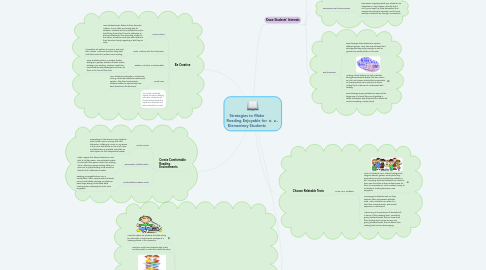
1. Create Comfortable Reading Environments
1.1. Quiet Spaces
1.1.1. Depending on the learner, some students would rather read in privacy with little distraction. Offering a corner, or any space in the room that blocks out as much noise and distraction as possible, would be an ideal option for the independent reader.
1.2. Encourages Collaboration
1.2.1. Offer a space that allows students to read with or to their peers. Some students prefer to read with their peers, rather than reading alone. Offering a group-reading table or a space for a group-reading circle would be ideal for the collaborative reader.
1.3. Comfortable Reading Spots
1.3.1. Reading is enjoyable when one is comfortable. Offer a space where students can sit comfortably, perhaps on pillows or bean bags. Being comfortable while reading makes reading that much more enjoyable.
2. Be Creative
2.1. Write Letters
2.1.1. Have students write letters to their favourite authors. This is often an exciting task for students. Students will be motivated to read a text if they know they'll have to elaborate on the text afterwards, such as writing a letter to the author. Students could also write letters to their friends or family regarding a text they've read.
2.2. Invite Authors into the Classroom
2.2.1. If possible, ask authors to come in and read their books. Authors know their story best, and often make the content more exciting .
2.3. Reader's Theatre or Playwrights
2.3.1. Have students perform a readers theatre dialogue in groups. Reader's theatre makes reading more exciting. Teachers could also have students read playwrights and then act them out in front of the class.
2.4. Book Wars
2.4.1. Have students participate in a book war. During a book war students create book reports. After their book reports students"battle"to explain why their book should win the book war.
2.5. Try not to constantly repeat the same reading activities. Students will become bored with the repetitive activities and lose motivation to read.
3. Differentiate Reading Activities
3.1. Offer Various Options in Order for Students to Read a Given Text
3.1.1. Have the option for students to follow along to a text with an audio book, perhaps at a listening station in the classroom.
3.1.2. Teachers could have students read a text and then watch a video that retells the story.
3.1.3. Allow students to read with a peer or reading buddy.
3.1.4. Offer texts in a students' native languages. Some students avoid reading because they are unfamiliar with the text language and are too shy to speak up. Offering a text that has the same content as the original English text allows students to understand what they are reading and allows them to compare the two languages.
3.1.5. Try not to constantly repeat the same reading activities. Students will become bored with the repetitiveness of activities and will view reading negatively.
3.1.6. Depending on the task and situation, allow students to choose what they read. Freedom of choice is an awesome way for students to feel like they are in charge of their learning.
4. Know Students' Interests
4.1. Surveys
4.1.1. Teachers could create surveys comprised of questions such as: Do you prefer to read about animals or people? Do you enjoy reading about history or about modern events ? From student answers teachers can base what books they choose for students to read.
4.2. Discussions and Conversation
4.2.1. Discussions regarding what your students' are interested in, may happen naturally, but if not, try and spark up class discussions that incorporate individual interests. Get to know what your students like through conversation.
4.3. Book Tastings
4.3.1. Book tastings allow students to explore different genres. They also help students find what genres they enjoy reading, as well as genres they would prefer not to read.
4.3.2. Hosting a book tasting not only indicates what genres students prefer, but also serves as a fun and unique activity that incorporates art (creating their own menus) and drama (acting like a customer at a restaurant) with reading.
4.3.3. Book tastings require students to read just the beginning of a book (they're just getting a taste) and explain why they would or would not continue reading a certain book.
5. Choose Relatable Texts
5.1. Know Your Students
5.1.1. Find out students' SES, cultural background, religious beliefs, gender, what sports they play, extracurricular activities they partake in, etc. Choosing texts that students can relate to their own lives often makes content easier for them to comprehend. When content is easy to understand, reading becomes more enjoyable.
5.1.2. Knowing your students well can help teachers offer and present relatable texts. When students can relate to a text, their comprehension and overall experience is enhanced.
5.1.3. Make sure you know where all students fall in terms of their reading level. Constantly giving students books that are lower than their reading level can be boring, and giving students books that are above their reading level can be discouraging.
